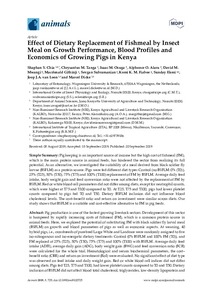| dc.contributor.author | Chia, S.Y. |
| dc.contributor.author | Tanga, C.M. |
| dc.contributor.author | Osuga, I.M. |
| dc.contributor.author | Alaru, A.O. |
| dc.contributor.author | Mwangi, D.M. |
| dc.contributor.author | Githinji, M. |
| dc.contributor.author | Subramanian, S. |
| dc.contributor.author | Fiaboe, K. |
| dc.contributor.author | Ekesi, S. |
| dc.contributor.author | van Loon, J.J.A. |
| dc.contributor.author | Dicke, M. |
| dc.date.accessioned | 2019-12-04T11:36:52Z |
| dc.date.available | 2019-12-04T11:36:52Z |
| dc.date.issued | 2019-09-20 |
| dc.identifier.citation | Chia, S.Y., Tanga, C.M., Osuga, I.M., Alaru, A.O., Mwangi, D.M., Githinji, M., ... & Dicke, M. (2019). Effect of dietary replacement of fishmeal by insect meal on growth performance, blood profiles and economics of growing pigs in Kenya. Animals, 9(10): 705, 1-20. |
| dc.identifier.issn | 2076-2615 |
| dc.identifier.uri | https://hdl.handle.net/20.500.12478/6369 |
| dc.description | Open Access Journal |
| dc.description.abstract | Pig production is one of the fastest growing livestock sectors. Development of this sector is hampered by rapidly increasing costs of fishmeal (FM), which is a common protein source in animal feeds. Here, we explored the potential of substituting FM with black soldier fly larval meal (BSFLM) on growth and blood parameters of pigs as well as economic aspects. At weaning, 40 hybrid pigs, i.e., crossbreeds of purebred Large White and Landrace were randomly assigned to five iso-nitrogenous and iso-energetic dietary treatments: Control (0% BSFLM and 100% FM (T0)), and FM replaced at 25% (T25), 50% (T50), 75% (T75) and 100% (T100) with BSFLM. Average daily feed intake (ADFI), average daily gain (ADG), body weight gain (BWG) and feed conversion ratio (FCR) were calculated for the whole trial. Hematological and serum biochemical parameters, the cost–benefit ratio (CBR) and return on investment (RoI) were evaluated. No significant effect of diet type was observed on feed intake and daily weight gain. Red or white blood cell indices did not differ among diets. Pigs fed T25, T75 and T100, had lower platelet counts compared to T0 and T50. Dietary inclusion of BSFLM did not affect blood total cholesterol, triglycerides, low-density lipoprotein and high-density lipoprotein. CBR and RoI were similar for the various diets. In conclusion, BSFLM is a suitable and cost-effective alternative to fishmeal in feed for growing pigs. |
| dc.format.extent | 1-20 |
| dc.language.iso | en |
| dc.rights | CC-BY-4.0 |
| dc.subject | Growth Period |
| dc.subject | Swine |
| dc.subject | Larval Stage |
| dc.subject | Animal Feeding |
| dc.subject | Cost Benefit Analysis |
| dc.subject | Returns |
| dc.subject | Investment |
| dc.subject | Dietary Supplements |
| dc.title | Effect of dietary replacement of fishmeal by insect meal on growth performance, blood profiles and economics of growing pigs in Kenya |
| dc.type | Journal Article |
| dc.description.version | Peer Review |
| cg.contributor.affiliation | Wageningen University and Research Centre |
| cg.contributor.affiliation | International Centre of Insect Physiology and Ecology |
| cg.contributor.affiliation | Jomo Kenyatta University of Agriculture and Technology |
| cg.contributor.affiliation | Kenya Agricultural and Livestock Research Organization |
| cg.contributor.affiliation | International Institute of Tropical Agriculture |
| cg.coverage.region | Africa |
| cg.coverage.region | East Africa |
| cg.coverage.country | Kenya |
| cg.isijournal | ISI Journal |
| cg.authorship.types | CGIAR and developing country institute |
| cg.iitasubject | Food Science |
| cg.iitasubject | Food Systems |
| cg.iitasubject | Nutrition |
| cg.iitasubject | Pests Of Plants |
| cg.journal | Animals |
| cg.howpublished | Formally Published |
| cg.accessibilitystatus | Open Access |
| local.dspaceid | 108007 |
| cg.targetaudience | Scientists |
| cg.identifier.doi | https://dx.doi.org/10.3390/ani9100705 |

